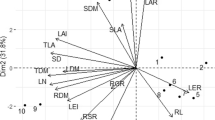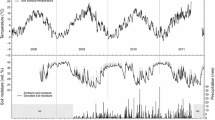Abstract
We investigated the carbon supply status in species-rich mediterranean plant communities growing in a bowl-shaped 1-ha “CO2 spring” area near Sienna, Italy. A geothermic “lime-kiln” has provided these communities, for as long as historical records are available, with pure CO2 that mixes with ambient air at canopy level to daytime means of 500–1000 ppm CO2. Immediately outside the spring area similar plant communities are growing on similar substrate, and in the same climate, but under ca. 355 ppm CO2. We found no evidence that plants in the CO2 spring area grow faster, flower earlier or become larger. However, we found very large differences in tissue quality among the 40 species studied inside and outside the spring area. Depending on weather conditions, the mean concentration of total non-structural carbohydrates (TNC, sugars and starch) in leaves of herbaceous plants was 38–47% higher in the spring area. Fast growing ruderals growing on garden soil inside and outside the spring area show the same response. Among trees, leaves of the deciduousQuercus pubscens contain twice as much TNC inside as outside the vent area, whereas evergreenQ. ilex leaves show no significant difference. TNC levels in branch wood paralleled leaf values. TNC in shade leaves was also higher. Elevated CO2 had no effect on the sugar fraction, therefore differences in TNC are due to starch accumulation. Leaf nitrogen concentration decreases under elevated CO2. These observations suggest that the commonly reported TNC accumulation and N depletion in leaves growing under elevated CO2 are not restricted to the artificial conditions of short-term CO2 enrichment experiments but persist over very long periods. Such an alteration of tissue composition can be expected to occur in other plant communities also if atmospheric CO2 levels continue to rise. Effects on food webs and nutrient cycling are likely.
Similar content being viewed by others
References
Acock B, Allen LH Jr (1985) Crop responses to elevated carbon dioxide concentrations. In: Strain BR, Cure JD (eds) Direct effects of increasing carbon dioxide on vegetation (Publ ER-0238). US Dept of Energy, Washington D.C, pp 53–97
Azcon-Bieto J (1983) Inhibition of photosynthesis by carbohydrates in wheat leaves. Plant Physiol 73: 681–686
Bazzaz FA, Fajer ED (1992) Plant life in a CO2-rich world. Sci Am 266: 68–74
DeLaunay L (1899) Recherche, captage et aménagement des sources thermominéales. Librairie Polytechnique Baudrie, Paris
Drake BG, Leadley PW (1991) Canopy photosynthesis of crops and native plant communities exposed to long-term elevated CO2. Plant Cell Environ 14: 853–860
Eamus D, Jarvis PG (1989) The direct effects of increase in the global atmospheric CO2 concentration on natural and commercial temperate trees and forests. Adv Ecol Res 19: 1–55
Evans JR, Seemann JR (1989) The allocation of protein nitrogen in the photosynthetic apparatus: costs consequences and control. In: Briggs WR (ed) Photosynthesis. Alan R. Liss, New York, pp 183–205
Field Ch, Mooney HA (1986) The photosynthesis-nitrogen relationship in wild plants. In: Givnish TJ (ed) On the economy of plant form and function. Cambridge University Press, Cambridge, pp 25–55
Francalanci GP (1959) Contributo per la conoscenza delle manifestazioni idrotermali della Toscana. Atti Soc Toscana Sci Nat Pisa Ser A, 65: 372–407
Grulke NE, Riechers GH, Oechel WC, Hjelm U, Jaeger C (1990) Carbon balance in tussock tundra under ambient and elevated atmospheric CO2. Oecologia 83: 485–494
Hunt R, Hand DW, Hannah MA, Neal AM (1993) Further responses to CO2 enrichment in British herbaceous species. Funct Ecol 17: 661–668
Idso SB, Kimball BA (1992) Effects of atmospheric CO2 enrichment on photosynthesis, respiration and growth of sour oranne trees. Plant Physiol 99: 341–343
Idso SB, Kimball BA, Allen SG (1991) CO2 enrichment of sour orange trees: 2.5 years into a long-term experiment. Plant Cell Environ 14: 351–353
Körner Ch (1993) CO2 fertilization: the great uncertainty in future vegetation development. In: Solomon AM, Shugart HH (eds) Vegetation dynamics and global change. Chapman and Hall, New York, pp 53–70
Körner Ch, Arnone JA III (1992) Responses to elevated carbon dioxide in artificial tropical ecosystems. Science 257: 1672–1675
Körner Ch, Arnone JA III (1993) Global change: the important difference between lettuce and forests. Plant Sci Bull 39: 8
Körner Ch, Diemer M, Schäppi B, Zimmermann L (1994) The response of alpine vegetation to elevated CO2. In: Koch GW, Mooney HA (eds) Terrestrial ecosystem response to elevated CO2. (Physiological ecology series). Academic Press, New York, in press
Leadley PW, Drake BG (1993) Open top chambers for exposing plant canopies to elevated CO2 concentration and for measuring net gas exchange. In: Rozema J, Lambers H, Geijn SC van de, Cambridge ML (eds) CO2 and biosphere. Kluwer Academic, Dordrecht, pp 3–15
Lincoln DE, Fajer ED, Johnson RH (1993) Plant-insect herbivore interactions in elevated CO2 environments. Tree 8: 64–68
Long SP, Drake BG (1992) Photosynthetic CO2 assimilation and rising atmospheric CO2 concentrations. In: Baker NR, Thomas H (eds) Crop photosynthesis: spatial and temporal determinants. Elsevier, Amsterdam, pp 69–101
Luxmoore RJ (1991) A source-sink framework for coupling water carbon, and nutrient dynamics of vegetation. Tree Physiol 9: 267–280
Miglietta F, Raschi A (1993) Studying the effect of elevated CO2 in the open in a naturally enriched environment in Central Italy. Vegetatio 105/105: 391–400
Miglietta F, Raschi A, Bettarini I, Resti R, Selvi F (1993) Natural CO2 springs in Italy: a resource for examining long-term response of vegetation to rising atmospheric CO2 concentrations. Plant Cell Environ 16: 873–878
Owensby CE (1993) Potential impacts of elevated CO2 and above-and belowground litter quality of tallgrass prairie. Water Air Soil Pollut 70: 413–424
Polley HW, Johnson HB, Mayeux HS (1992) Growth and gas exchange of oats (Avena sativa) and wild mustard (Brassica kaber) at subambient CO2 concentrations. Int J Plant Sci 153: 453–461
Poorter H, Gifford RM, Kriedemann PE, Wong SC (1992) A quantitative analysis of dark respiration and carbon content as factors in the growth response of plants to elevated CO2. Aust J Bot 40: 501–5113
Rowland-Bamford AJ, Allen LH Jr, Baker JT, Boote KJ (1990) Carbon dioxide effects on carbohydrate status and partitioning in rice. J Exp Bot 41: 1601–1608
Sage RF, Sharkey TD, Seemann JR (1989) Acclimation of photosynthesis to elevated CO2 in five C3 species. Plant Physiol 89 590–596
Saposchnikoff W (1893) Beitrag zur Kenntnis der Grenzen der Anhäufung von Kohlenhydraten in den Blättern. Ber Dtsch Bot Ges 11: 391–393
Scheidegger UC, Nösberger J (1984) Influence of carbon dioxide concentration on growth, carbohydrate content, translocation and photosynthesis of white clover. Ann Bot 54: 735–742
Schulze W, Stitt M, Schulze ED, Neuhaus HE, Fichtner K (1991) A quantification of the significance of assimilatory starch for growth ofArabidopsis thaliana L. Heynh. Plant Physiol 95: 890–895
Sharkey TD (1985) Photosynthesis in intact leaves of C3 plants: physics, physiology and rate limitations. Bot Rev 51: 54–105
Stitt M (1991) Rising CO2 levels and their potential significance for carbon flow in photosynthetic cells. Plant Cell Environ 14: 741–762
Strain BR, Cure JD (eds) (1985) Direct effects of increasing carbon dioxide on vegetation (DOE/ER-0238). US Dept Energy, Office of Energy Research, Washington D.C.
Williams WE, Garbutt K, Bazzaz FA (1988) The response of plants to elevated CO2. 5. Performance of an assemblage of serpentine grassland herbs. Environ Exp Bot 28: 123–130
Wittwer SH (1984) Carbon dioxide levels in the biosphere: effects on plant productivity. CRC-Critical Rev Plant Sci 2: 171–198
Wong SC (1990) Elevated atmospherical partial pressure of CO2 and plant growth. II. Non-structural carbohydrate content in cotton plants and its effect on growth parameters. Photosynth Res 23: 171–180
Woodward FI (1992) Predicting plant responses to global environmental change. New Phytol 122: 239–251
Woodward FI, Thompson GB, McKee IF (1991) The effect of elevated concentrations of carbon dioxide on individual plants, populations, communities and ecosystems. Ann Bot 67: 23–38
Wulff RD, Strain BR (1982) Effects of CO2 enrichment on growth and photosynthesis inDesmodium paniculatum. Can J Bot 60: 1084–1091
Author information
Authors and Affiliations
Rights and permissions
About this article
Cite this article
Körner, C., Miglietta, F. Long term effects of naturally elevated CO2 on mediterranean grassland and forest trees. Oecologia 99, 343–351 (1994). https://doi.org/10.1007/BF00627748
Received:
Accepted:
Issue Date:
DOI: https://doi.org/10.1007/BF00627748




